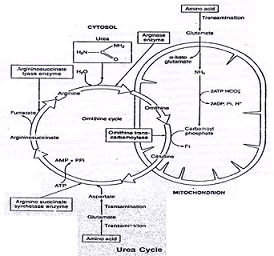Introduction
This is the process where nitrogenous waste products are excreted in the form of urea. Ureotelic organisms are the organisms that excrete nitrogenous wastes in the form of urea.
Ureotelism is one of the three other ways through which nitrogen is excreted from the bodies of living things. The other two processes of nitrogenous waste removal are ammonotelism and uricotelism.
Urea, the nitrogenous waste product of ureotelic animals is less toxic in comparison to ammonia excreted by ammonotelic animals. Furthermore, urea is more toxic than uric acid excreted by uricotelic living things. Urea requires 0.05 litres of water for the excretion of 1 gram of nitrogen, just 10% that is required in ammonotelic organisms.
Examples of ureotelic organisms are adult amphibians, mammals, bony fish and cartilaginous fish. Humans are also among ureotelic organisms.
The Ornithine Cycle.
The ornithine cycle, otherwise called the urea synthesis or Kreb-Henseleit cycle, is the biochemical process of excretion in ureotelic organisms. This process occurs in the liver.
The process of urea synthesis.
- Formation of carbamyl phosphate by the combination of carbon dioxide, ammonia and Adenosine triphosphate (ATP).
- Formation of citrulline by the combination of carbamyl phosphate with ornithine.
- Joining of citrulline with aspartic acid where citrulline changes to arginino succinic acid
- Arginino succinic acid breaks into fumaric acid and arginine.
- Hydrolyzing arginine to form urea and ornithine with the help of enzyme arginase.

Hyperammonemia.
Liver malfunctions may cause hyperammonemia, which causes dysfunctions in the central nervous system (CNS) such as convulsions, coma and brain oedema.
The use of antibiotics and lactulose are some of the current ways of treating hyperammonemia, whereby they are designed to reduce the formation of ammonia and its absorption into the body. These methods have proved infective, furthermore, accompanied by side effects.
It has been shown in recent years that the modification of microbiota in the gut could be an effective way of treatment of hyperammonemia.
The severity of neurological dysfunctions depends on:
- Age of the patient.
- Type of hyperammonemia, i.e. acute or chronic.
- Degree of hyperammonemia.
It is therefore important that ureotelic organisms get rid of ammonia as soon as possible to avoid harmful actions of too much ammonia in the body.
Uses of ammonia.
- Small amounts of ammonia are released into the bloodstream or excreted into urine facilitating the secretion of protons.
- Majority of ammonia is reutilised in the biosynthesis of nitrogenous compounds including amino acids.